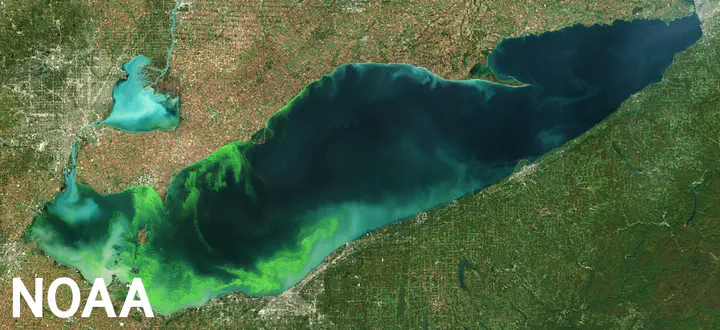
We have developed a bayesian network model for nutrient source attribution in Maumee River Basin. Pre-print of our research is available online.
Summary
Surface water nutrient pollution, the primary cause of eutrophication, remains a major environmental concern in Western Lake Erie despite intergovernmental efforts to regulate nutrient sources. The Maumee River Basin has been the largest nutrient contributor. The two primary nutrients sources are inorganic fertilizer and livestock manure applied to croplands, which are later carried to the streams via runoff and soil erosion. Prior studies on nutrient source attribution have focused on large watersheds or counties at long time scales. Source attribution at finer spatiotemporal scales, which enables more effective nutrient management, remains a substantial challenge.
This study aims to address this challenge by developing a portable network model framework for phosphorus source attribution at the subwatershed (HUC-12) scale. Since phosphorus release is uncertain, we combine excess phosphorus derived from manure and fertilizer application and crop uptake data, flow dynamics simulated by the SWAT model, and in-stream water quality measurements into a probabilistic framework and apply Approximate Bayesian Computation to attribute phosphorus contributions from subwatersheds.
Our results show significant variability in subwatershed-scale phosphorus release that is lost in coarse-scale attribution. Phosphorus contributions attributed to the subwatersheds are on average lower than the excess phosphorus estimated by the nutrient balance approach adopted by environmental agencies. Phosphorus release is higher during spring planting than the growing period, with manure contributing more than inorganic fertilizer.
By enabling source attribution at high spatiotemporal resolution, our lightweight and portable model framework is suitable for broad applications in environmental regulation and enforcement for other regions and pollutants.
Key points
-
Our lightweight and portable framework integrates input, water quality, and flow dynamics to attribute sources of surface-water phosphorus
-
Phosphorus release varies significantly at the subwatershed scale and peaks in the spring planting period
-
Manure contributes more to phosphorus release than inorganic fertilizer in the Maumee River Basin
Conference Presentation
The research has been presented in AGU fall meeting 2022. The poster of the presentation is available here.